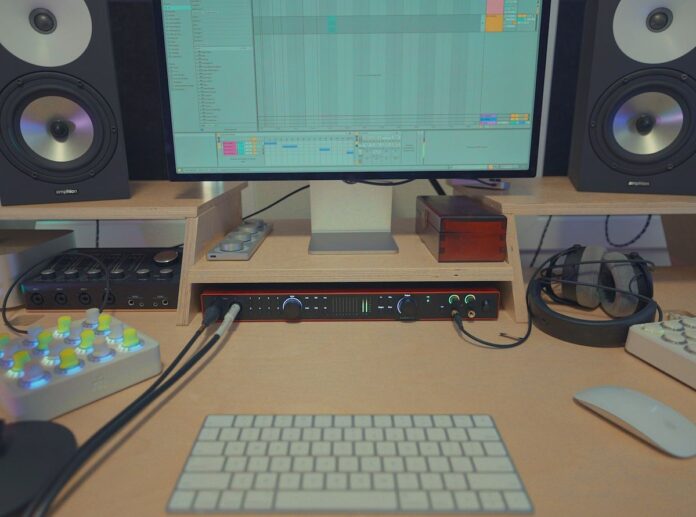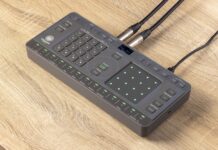We’re living in a golden age of music production gear, where pro-level sound isn’t locked behind the glass in high-end studios, it’s now right on your desk! Right now, it’s on my desk. The Scarlett 18i20 4th Gen (available here in the DJTT store) is a shining example of this shift, bringing serious studio chops to the home and stage for bedroom producers, smaller home studios, and electronic musicians who want clean sound, sleek control, and flexible routing without breaking the bank. Keep reading for my review.
Built for the Hybrid Hustle
Whether you’re tracking vocals, instruments, routing gear in a modular live rig, or streaming a DJ set, the Scarlett 18i20 delivers. With 18 inputs and 20 outputs, USB-C connectivity, and a surprisingly low noise floor, it’s perfect for the modern multi-tasking setup. Now technically it has 8 analog mic preamps, with the rest of the inputs handled digitally. Personally I’m not using all 8 analog preamps at the same time but it’s good to have instruments hooked up to the interface so I can just start recording them anytime I want. Normally with a 2 input interface, I would have to disconnect and reconnect cables which can quickly become tedious.
You also get MIDI In and Out, which is ideal for syncing external gear like grooveboxes, synths, or even lighting setups. It’s a plus if you have devices that don’t support USB-MIDI. I have an old Roland Juno-106 that I hook up via the 5 pin MIDI connectors.
It also has ten line outputs (including dual monitor sets), two fully independent headphone outs, and front panel switching for Main/Alt monitors. I really appreciate the Dim switch, which makes it easier to quickly reduce volume and go back to the previously set level without too much fiddling.
Also: yes, it looks good. The matte-black finish and subtle LED metering give it a studio-ready vibe to impress visitors.

Clean Gain + “Air” Flair
One of the biggest wins? The preamps. They’re clean, quiet, and have enough gain to comfortably drive even the famously gain-hungry Shure SM7B. No cloudlifter or preamp gymnastics needed. Just plug in, crank it, and go. I’ve always had to deal with gain issues with my SM7B on other interfaces and am glad this is not the case with the Scarlett. In this 4th generation, Focusrite has removed the dedicated analog gain knobs which is a bummer for some people who like having hands on control but on the flip side, the digital controls means that you can save them as preset configurations which can be quite handy. I have a preset for my Zoom classes and a separate one for my recording sessions.
There’s also the Air Mode, which adds a noticeable lift in the upper frequencies, which has been a Scarlett series staple for a while. New in this version is the “Presence + Drive” option, which adds just a bit of harmonic push for vocals or instruments that need to cut through a dense mix, ideal for layering synths or spicing up vocal hooks. A little bit of analog flavor, why not?

Control Room in Your Backpack
The Focusrite Control 2 software is super intuitive and makes the 18i20 feel like a full-blown digital mixer. You can route, mix, monitor, and tweak without diving into your DAW. It’s incredibly handy for setting up cue mixes or handling audio for hybrid setups. As I mentioned earlier, you can save multiple presets of your configurations for quick recall.
Rare Feature: Built-in Loopback
Let’s talk about the Scarlett 18i20’s Loopback function which is a unique and rare feature that I haven’t seen on any audio interface, particularly in this price range.
With Loopback, you can internally route your system audio (DAW output, browser audio, etc.) back into the interface without any patch cables or workarounds. That means:
- Stream DJ sets with mic + computer audio to Twitch or OBS
- Sample sounds directly from YouTube or Spotify into your DAW
- Record Zoom calls or screen tutorials with both voice and system audio
- Balance backing tracks with live vocals for an online performance
I normally use a software loopback solution which does give me a lot more configuration options, but again nice to have this built-in on the audio interface for a quick loopback solution.

Auto Gain
Focusrite introduced Auto Gain as a way to set levels with a single button press. Feed in a signal, and the interface analyzes it to suggest an optimal gain level. At first it seemed unnecessary, but after using it, I found it to be a useful way to get an initial level for my audio signals coming into the interface. Keep in mind, if the incoming audio eventually changes, you will still have to adjust the gain manually, or just use the Auto Gain option again.
Final Verdict
The Scarlett 18i20 4th Gen proves you don’t need to spend $1,000+ to get professional studio quality. Whether you’re a DJ routing outboard gear, a producer tracking instruments, or a live electronic artist running multichannel I/O, this interface punches above its weight.
For producers and DJs ready to level up their I/O game, the Scarlett 18i20 4th Gen is a no-brainer. Here’s a quick list of pros and cons to really break it down for potential purchasers.
Pros:
- Super clean, powerful preamps
- Slick Air mode for high-end sparkle
- Focusrite Control 2 software is intuitive and powerful
- Loopback = modern, flexible workflow
- Affordable price point for the I/O count
- Runs in standalone mode (without computer), something I don’t use much myself.
Cons:
- No dedicated knobs for input control
- No onboard DSP for effects (but at this price, you can’t really expect that)
If you're looking to buy this soundcard, we've got it in the DJTT webstore here. Support us with your purchase by shopping there :)











